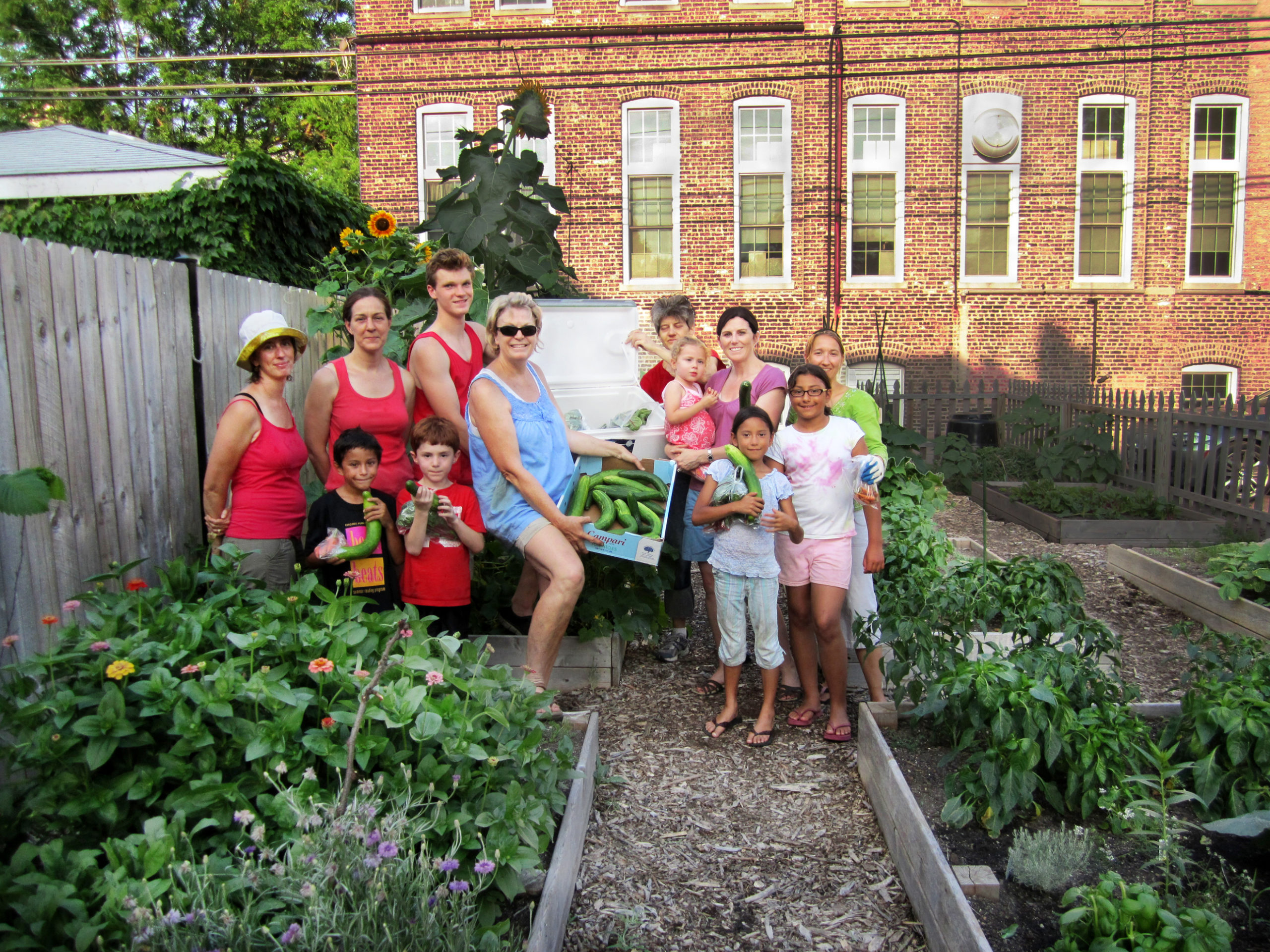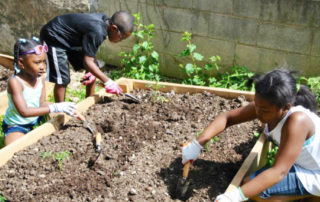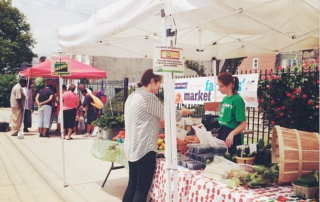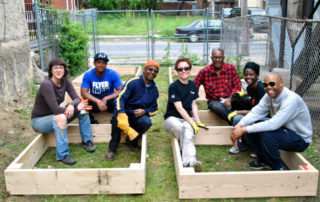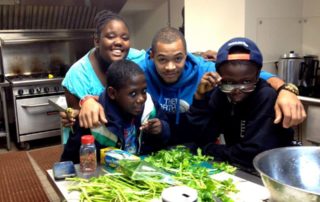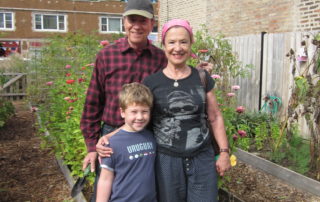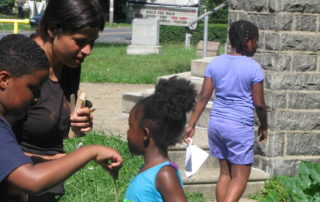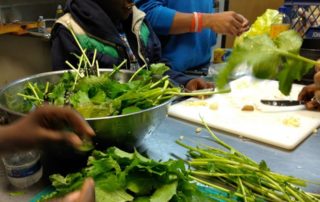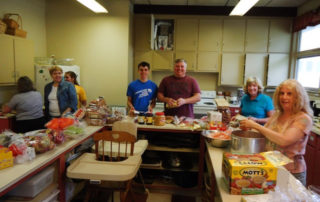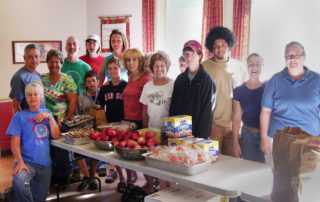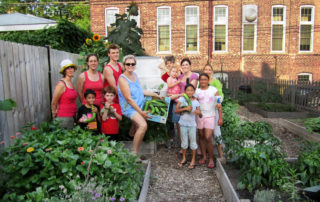Food and sacred places have always gone hand in hand. Whether serving their congregants after worship or the local community in general, congregations have long been hubs for food. Two of the most common social programs run by congregations are food pantries and soup kitchens.
Food in Sacred Places (FiSP) was an innovative program that connected congregations with health experts nationwide to foster:
- conveniently located health and nutrition programming
- widespread access to fresh, ethically grown food; clean, safe, green-spaces; entrepreneurship opportunities; and health care
- a sustainable infrastructure to affordably feed our community
To execute this mission, we:
- provided support to congregations seeking to license their facilities as shared kitchens
- acted as matchmakers and facilitators for partnerships between congregations and nutrition, health, and environmental professionals
- provided tools such as training, documentation, budget, and legal assistance
The Need and the Opportunity
An overwhelming number of low-income families, in both rural and urban America, are disconnected from food systems that would provide them with affordable and nutritious food in convenient and culturally appropriate ways. According to a 2009 USDA report, 23.5 million people in the U.S. live in a low-income area located more than one mile from a supermarket. Studies conducted by The Food Trust, a food justice nonprofit, indicate that lack of access to affordable, fresh food is, “negatively associated with low-income residents’ health and economic well-being.” Community members who must, “travel outside of their neighborhoods to purchase food or shop at smaller corner and convenience stores,” generally encounter, “lower-quality food, limited fresh choices, and substantially higher prices.”
Through our conversations with environmental organizations, health centers, food justice groups, and faith communities, we have seen a clear sense of shared purpose. Supported by a strong theological framework, many faith leaders honor the relationship between caring for their congregations and care of the land and understand the connection between stewardship and environmental, social, and economic justice. At the same time, nutrition, farming, and greening organizations are engaging, mobilizing, and organizing people to improve access to community health. Recognizing this alignment in community and congregational vision, the Food in Sacred Places program intertwines theology, ecology, and food justice to promote a renewed sense of environmental stewardship and how such stewardship supports a sustainable food system.
Partners’ Solution and the FiSP Program
Partners provided a key value in its role as an umbrella organization, uniting congregations for greater impact through its position as a trusted facilitator. Partners acted as a liaison between health, nutrition, and environmental organizations and interested congregations, providing both parties with potential partnership options, project development assistance, and the training needed to enact these transformative programs. Depending on the assets of each sacred space, congregations and a community partner could:
- grow food on their outdoor green space
- present community programs such as cooking or nutrition classes in their kitchens and social halls
- host environmental education events, entrepreneurship opportunities, farmers’ markets, incubator kitchens, community supported agriculture programs, or clinics on their premises
- act as a convener for food justice and environmental activists
The individualized partnership structure of the program offered a mosaic of initiatives to change food and environmental systems and, ultimately, build upon each congregation’s mission and vision.
Case Studies
Broadway United Methodist Church: Community Organizing and Gardening
There are many ways a congregation can mobilize a community for the common good. In some cases, it works for institutions to create ministries and programs that address social ills. But focusing on what the community lacks and importing solutions can sometimes be counterproductive. Instead, as the story of Broadway United Methodist Church (BUMC) in Indianapolis, IN, demonstrates, efforts to improve a community can harness the gifts that are already present.
In 2005, BUMC initiated “Miracle on 29th Street: Realizing Dreams, Building Community,” a campaign to raise funds to maintain the church property, sustain its ministries, promote new ones, and engage in community development. To accomplish the latter goal, the church hired “roving listeners,” community organizers who would survey the Mapleton-Fall Creek neighborhood to find its strengths. Those assets, not social ills or economic hardships, would be the starting point of development.
Community organizer De’Amon Harges started roving and listening in early 2007. By simply talking to local residents, he discovered the interests and talents of the community. But one discovery stood out in particular. “I found many gifts,” recounts Harges, “but the one that was most surprising to me was that there were over 75 gardeners.” This discovery made it clear why a community garden had shut down three years earlier: not only was it poorly maintained, but also it simply was not part of the pulse of the neighborhood. It had been created in a top-down fashion, ignoring the fact that the area was already filled with gardeners who worked in their backyards and front porches. It became clear that the way to build the neighborhood’s capacity would be bottom-up, by strengthening its existing structures. As opposed to focusing on what people are not doing, “we build on what people are actually doing,” says Harges. “We build on [their] gifts, talents, and dreams.”
BUMC’s model of community development is asset-based, meaning that organizers seek out pre-existing resources and build connections between those assets and institutions. In the case of food and sacred places, Reverend Mike Mather explains the two-step process, “One, talk to the gardeners, find out what they are growing, what they’d be willing to sell, what price they’d be willing to offer, and how they’d be willing to distribute, and then, two, talk to churches and businesses in this neighborhood and find out who would be willing to buy.” Thus, the congregation facilitated community development by connecting the people already present in the neighborhood.
With this unique approach, BUMC and the roving listeners made significant progress toward the stated goals of the unsuccessful community garden: improved access to fresh produce, secure and local food networks, and sustainable economic development. By late 2007, several partnerships had been created between gardeners and other organizations in Indianapolis.
In June of 2009, administrators of the local hospital heard about the church’s organizing initiatives and reached out to Reverend Mather. They proposed starting a farmer’s market at the hospital, featuring neighborhood gardeners. Initially, Reverend Mather was concerned about the investment of time and money that this project would require. Fortunately, the hospital used its own seed funding to cover the costs and as a result, the first local farmer’s market at Methodist Hospital is scheduled for this summer.
For Reverend Mather, the key to this story is perspective. “We saw what had been around us all along. What previously had been invisible was made visible.” By making connections between people, their gifts, and local institutions, Broadway United Methodist Church is creatively rethinking how congregations engage with their communities in general. As a result, the roving listeners have forged a new frontier in food and sacred places.
St. Michael’s Lutheran Church: Philadelphia Incubation Community Kitchens
Since 1997, Greensgrow Farms has pioneered urban agriculture in the Kensington neighborhood of Philadelphia, reclaiming abandoned land and building green business as a force for neighborhood revitalization.
Greensgrow is known for it farm-sourced goods like pesto and roasted eggplant dip. These products need space for preparation and canning, which for a time had been done at a small kitchen in the main office. But as the business expanded and demand increased, Greensgrow’s existing facilities could no longer handle the volume.
St. Michael’s Lutheran Church, located a few blocks down the street from Greensgrow Farms, heard about its projects and expansion. The church’s large kitchen had been preserved well by the congregants, but it was outdated and not in line with the city’s health regulations. So a partnership was born: Greensgrow would renovate the kitchen, bring it up to code, and use the space to prepare its farm goods.
But St. Michael’s is more than just a space for Greensgrow to make assorted foodstuffs. Rather, the renovations and improvements allowed for the creation of the Kensington Community Kitchen. This new initiative made St. Michael’s the center for Greensgrow workshops and classes on sustainability, nutrition, and urban farming. In addition, the kitchen was perfect for local food entrepreneurs burdened by the costs of maintaining their own space.
The Community Kitchen facilities have brought tremendous benefit all to parties involved: Greensgrow acquired new space for its own food preparation and culinary education classes; the local food industry gained a new space for food entrepreneurs in need of affordable expansion; and St. Michael’s found a new partnership that resulted in structural renovations and increased visibility in the community.
Roxborough Presbyterian Church: Orchards in Sacred Places
29 orchards. 374 trees. 751 shrubs and vines, countless perennials. These are the current tallies in the Philadelphia Orchard Project’s (POP) efforts to beautify urban spaces, promote environmentally friendly development, and provide accessible fresh produce to high-poverty neighborhoods.
Founded in 2007, POP is dedicated to reclaiming unused land for sustainable development and ethical, local food systems. One of the biggest challenges facing low-income residents in large cities like Philadelphia is access to healthy and affordable food, as fresh produce is both expensive and geographically distant from high-poverty neighborhoods. Orchards can reduce a community’s reliance on imported foods by providing cheaper and fresher local alternatives.
POP works with organizations of all stripes – nonprofits, public parks, community gardens, elementary schools, and religious congregations – developing partnerships to plant and maintain urban orchards. One such congregation is Roxborough Presbyterian Church (RPC), whose POP orchard was planted in October 2009.
But the partnership with POP was not the congregation’s first foray into horticulture, as RPC member Elizabeth Vecchione originally had the idea for a community garden in late 2008. After realizing how much underutilized land the church owned, she saw the perfect opportunity for a communal space that would improve the church’s outreach and relationship with its neighbors. It would also make an important environmental contribution, as community gardens provide locally grown, fresh produce to areas that would otherwise not have access to these healthy food alternatives. In the spring of 2009, the Roxborough Presbyterian Community Garden was born.
The community garden immediately became an integral part of RPC’s community outreach efforts. Offering a hands-on educational experience in the garden, Vecchione reached out to local schools, after-school clubs, and youth groups. Unsurprisingly, according to Vecchione, “we’ve found that many kids like to get their hands dirty” while they’re learning the finer points about composting and rain water collection systems.
RPC’s activities made for a natural partnership with POP, as the congregation had already been working towards the same goal of creating stable and sustainable food networks through local gardening.
In general, candidates for POP orchards must meet four main criteria, explains Orchard Director Phil Forsyth. “They need long-term site access, the demonstrated capacity to care for the orchard, the right environmental factors, and distribution to low-income neighborhoods.” The middle two are perhaps the most important – not only do orchard candidates need the manpower to care for the plants, but the land itself needs to be environmentally viable. Says Forsyth, “we need to check that the space has a water source, enough sun exposure, fencing to prevent vandalism, and the right soil that can handle an orchard.”
Fortunately, RPC’s community garden met all of those criteria. Vecchione submitted an application in the summer of 2009, and by autumn, her team of church and community volunteers planted their first trees and berry bushes.
In line with POP’s organizational goals, one of the conditions for this unique partnership is that the produce must benefit low-income areas. Distribution can take several different forms: sales to support community organizations, direct donations to food banks or individuals, and free, open harvests. Though Roxborough Presbyterian is not located in a low-income neighborhood, it is looking to satisfy its distribution requirement through other means. Vecchione hopes that once its trees and berries bear fruit, the garden will stock the food pantry of a nearby community center.
An orchard is a serious commitment, one that RPC could not have undertaken without the active engagement and investment of Vecchione and the entire leadership team. Although POP provides advice and support with the initial planting, maintenance is entirely the job of the partner. To realistically handle the demands of this project, Forsyth explains that congregations “need a group of really dedicated people to care for an orchard. You need to plant, water, weed, harvest, etc. You’ve got to care for it on a day-to-day basis.” Fortunately, RPC had just that – a dedicated team of volunteers who worked hard to make this partnership a reality.
While the commitment has certainly been demanding, the rewards of building community and contributing to sustainable food networks have been well worth the effort. Says Vecchione, “the Community Garden has let the congregation share talents for gardening, construction, and helpfulness, while getting to know our neighbors surrounding the church. We feel truly blessed to have met and work with our neighbors. We may be growing things together, but it’s the relationships that are the most rewarding.”
St. Paul’s Episcopal Church: Hurricane Irene and the “Freeway Relay”
When Hurricane Irene hit Vermont in August 2011, the destruction was devastating. Heavy damage to roads and bridges left some towns completely isolated and dependent on airlifts for food and supplies. Once the storm had subsided, evacuated families returned to find their homes flooded with several feet of mud and water. Some houses were knocked completely off their foundations. As a result, many Vermont residents were left devastated and traumatized.
St. Paul’s Episcopal Church is located in White River Junction, one of five villages in the town of Hartford (whose other villages contained some of the hardest hit areas). The Reverend Nancy Vogele, rector of St. Paul’s, immediately reached out to Hartford’s town manager and asked what her parish could do to help. No sooner did she receive a request to prepare food for rescue workers than the St. Paul’s community quickly sprang into action. The next day, a team of volunteers met in the church kitchen, made 50 sandwiches, and drove down to the nearby village of West Hartford to distribute them.
The newly formed Hurricane Irene Relief Ministry set its sights on providing much-needed food and supplies for victims of flooding in the region. From the few volunteers that started the relief effort, word quickly spread throughout the neighborhood and attracted dozens of new volunteers every day.
Ministry coordinator Holly Hall was astounded by the outpouring of support from the community. “Nobody could figure out how it happened so quickly, but it did. People – including people I’d never seen before – showed up at the door and asked, ‘How can we help?’” From longtime parishioners to total strangers, and even a few vacationers from a nearby ski resort, the entire community was represented in St. Paul’s kitchen.
Initially, all of the materials for the casseroles, sandwiches, and salads that volunteers prepared came from congregational funds. But in the weeks and months that followed, donations from local grocery stores and eateries came pouring in. Other sources were less formal, such as when volunteers would arrive at St. Paul’s with their own fresh fruits and vegetables in tow. Students from a local elementary school made their own baked goods for the relief efforts. Jean Kendrick, another coordinator for the relief ministry, believes that “there was not a business or family in the White River Valley that didn’t donate something.”
Volunteers were also involved in all facets of relief. They assisted in fundraising for the ministry, and helping those in need contact formal relief agencies. Most importantly, volunteer drivers transported food from St. Paul’s all across eastern Vermont. This network was dubbed “the Freeway Relay,” referring to the nearly constant supply of food and supplies in transit along the state’s main highways. Food from St. Paul’s kitchen would be loaded into a car and taken down the interstate to a nearby town, where it would be passed on to other volunteers and distributed across the state’s hardest hit areas.
Through the end of September 2011, the relief ministry was operating seven days a week. As time went on, the volunteer effort thinned to five days a week, then three days a week. It now continues to operate one day a week. Though it’s been months since Hurricane Irene hit, there are still many Vermont residents in need of assistance.
Without a corporate structure, the relief ministry was largely an ad-hoc operation. The door to St. Paul’s was always open, so every day would bring new people, new materials, and new challenges. The daily numbers were in constant flux, so volunteers had to coordinate with their contacts in the affected towns as people’s needs changed. And those numbers were quite impressive. At its peak, St. Paul’s Hurricane Irene Relief Ministry was preparing almost 700 meals per day. An estimated 7,000 meals had been distributed through its first three months of operation.
On the surface, most of the relief work has been material support. But while sandwiches and casseroles may satisfy appetites, it’s the moral support of volunteers that mends broken spirits. Reverend Vogele noted that providing food and supplies has been “an entrée into people’s lives. It’s been a way to keep their spirits up. It means a lot to people to know that we haven’t forgotten them.” Relief coordinator Kendrick agreed, noting, “We’ve made really strong bonds with people. The food has always been a way into people’s homes so we can support them.”
When it comes to St. Paul’s relief ministry, it’s easy to get lost in the sheer volume of sandwich-making, transportation, and volunteer hours. But the statistics, while impressive, hide the human element and do not tell the whole story of what Kendrick called “an emotional journey.” In post-Irene Vermont, food has been an effective and meaningful way to create relationships and strengthen emotional bonds with the Hartford community and beyond.
Irving Park Lutheran Church: Three Brothers Garden
On a warm summer evening in northwestern Chicago, a small lot in the West Walker neighborhood is buzzing with activity as volunteers gather at the community garden for the weekly evening harvest. No one sent a call for action – members just show up to pick, weigh, wash, and bag produce to donate to the nearby Irving Park Community Food Pantry. The evening harvest includes carrots, tomatoes, peppers, lettuce, and cucumbers, with no rotten or wilted vegetables allowed. Seeds have been planted and friends have been made, as local residents have gathered together to harvest quality, nutritious, locally grown food.
Three Brothers Garden is named in honor of Helge, Carl, and George Carlson, all longtime members of Irving Park Lutheran Church (IPLC). Following the death of the last brother, a bequest was made to the church, which used those funds to establish a nonprofit organization in the brothers’ name. Carlson Community Services was established in 2004 and has since been dedicated to community outreach through afterschool children’s activities, fine arts programming, immigrant assistance, and senior citizen services. Two years later, IPLC bought a house on the plot where the garden now lies. The church explored ideas for the building, which sat on a long and narrow city lot, but ultimately, reusing it was more than they wanted to take on at the time and they decided to demolish.
Recognizing a new opportunity for community outreach, CCS asked the congregation about using the now-vacant land for a community garden. So in early 2009, the organization held a well-attended public meeting and considered two concepts: rental plots for local residents to grow their own produce, or a garden that would support the local food pantry. CCS chose the latter charitable option as the project focus. Like most food pantries, much of the food donated to the Irving Park Community Food Pantry (IPCFP) was prepackaged, so a weekly donation of fresh produce was a very welcome addition to the IPCFP’s shelves.
The garden has brought local leaders and neighbors together in common cause. For example, a community chili supper in spring 2009 raised $3,000 for the project. A local garden center donated seeds that hadn’t sold the previous year. With the help of the neighborhood alderman, CCS secured a grant from the Marx Foundation. On the church level, the Metropolitan Chicago Synod also gave a grant for new missions to help establish the garden. Volunteers included neighbors, youth groups, scouts, businesses, and friends of CCS. The church cleaned the lot, built twenty raised beds, laid organic soil, and planted the seeds. By the end of October 2009, garden volunteers had donated 576 pounds of produce directly to the pantry.
From its humble beginnings, Three Brothers Garden has grown dramatically. In those same twenty beds, the garden yielded 725 pounds of produce in 2010, and just last year, it donated 786 pounds of locally grown food to the food pantry. Technological improvements were not far behind. While volunteers had originally watered the garden themselves with the church’s hose and sprinkler, by June 2011, CCS had raised the necessary funds to install a full irrigation system. Later that summer, CCS hired a garden coordinator to oversee the entire project. Local Eagle Scouts provided other important additions, including a compost bin, a garden shed, a deck, and a pergola. Moving forward, the next phase of the project will entail better signage and a few flowerbeds, while also trying to involve pantry clients as much as possible.
Over the years, the garden has become a community-gathering place. Potluck suppers are held twice a month under the pergola, as are garden and cooking classes, and children’s programs. Volunteers have formed a book club that reads one book each season and meets for their discussions in the garden space. Currently, the garden has reached a size and capacity that is sustainable, and CCS executive director Liz Mills notes that future funds will go toward additional programming as opposed to improvements.
Though the community garden has turned out to be quite successful, Irving Park Lutheran Church did not have any specific background or special preparation for this project. Indeed, Reverend Brooke Petersen points out that this was the first time the church had gotten involved in a gardening ministry. Yet, “there was a sense of outreach for a long time and the [gardening] ministry was in line to where God was calling us.” By partnering with CCS, the garden has brought more church awareness in the community and overall goodwill. This initiative has helped Irving Park Lutheran Church build a well-deserved reputation as a congregation that cares for and is invested in the community. The excitement around the Three Brothers Garden – whether for its gardening work, cooking classes, or social events – has been contagious, attracting new partners and friendly neighbors.

